Forts of Oman
The Sultanate of Oman is famed all over the world for housing some of the world’s most historic battlements and crenellations in the form of awe-inspiring forts that are dotted everywhere along the country’s landscape: perched upon mountaintops, or nestled within deep ravines. Each fort has distinctive engineering and architectural features that showcase the intellect of the architects in designing elaborate fortifications to secure the land from foreign enemies.
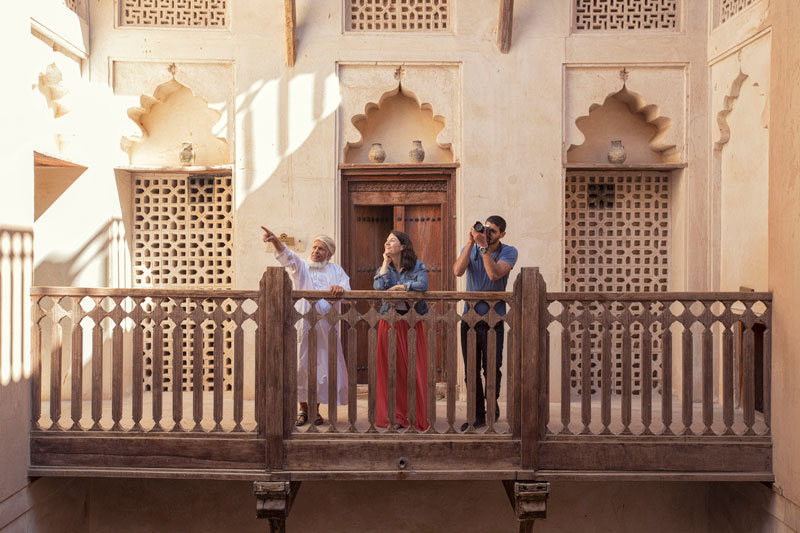
JABREEN CASTLE
Standing proud for more than 300 years since its inception in 1692, Jabreen Castle is one of the country’s most fascinating and awe-inspiring buildings, full of amazing details, intricate frescoes, and elaborate inscriptions that distinguish it from the Sultanate’s other castles. Built as the palace of Imam Bil Arab Bin Sultan Al Ya’rubi, and housing his final resting place, Jabreen Castle is an authentic expression of Omani craftsmanship. From the top, the views of the Al Hajar foothills render stunning photographic opportunities for the visitor.
Phone: 94495594
www.instagram.com/jabreencastleofficial
- Location : Jabrin, 20km from Bahla
- Governorate: Al Dakhiliyah
Make sure to check out Jabreen Castle’s most famous rooms: The Sun & Moon Room, which was used by the Imam for discussions and consultations, and The Imam Protection Room, which the Imam’s soldiers used to hide in when he was meeting someone he did not trust. Both rooms are adorned with beautiful Islamic calligraphy and motifs.
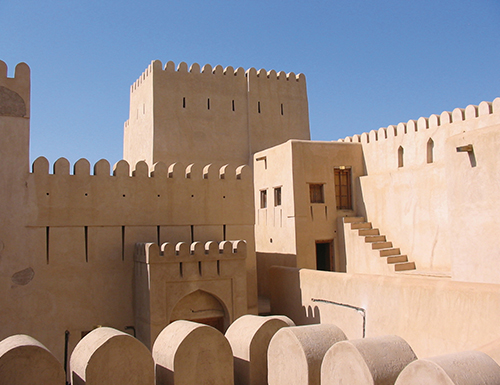
NIZWA FORT
Considered to be the largest of its kind on the Arabian Peninsula, the Nizwa Fort towers above its surroundings, standing as a reminder of the important status that the city of Nizwa once held as the Islamic, political and cultural capital of Oman. Built over a span of 12 years by Imam Sultan Bin Saif Al Ya’rubi in the middle of the 17th century on top of the remains of a 9th century castle, this enormous fort features a huge central tower which has an outer diameter of 43 meters. Access to the tower is through a series of narrow corridors and dark, dingy staircases that are guarded by thick, spiked wooden doors.
www.instagram.com/nizwafortoman
- Location : Wilayat Nizwa
- Governorate: Al Dakhiliyah
Tips: View Nizwa Fort’s exhibition hall that contains information regarding the history of the fort, its construction and architecture, to fully appreciate the status of this important building.
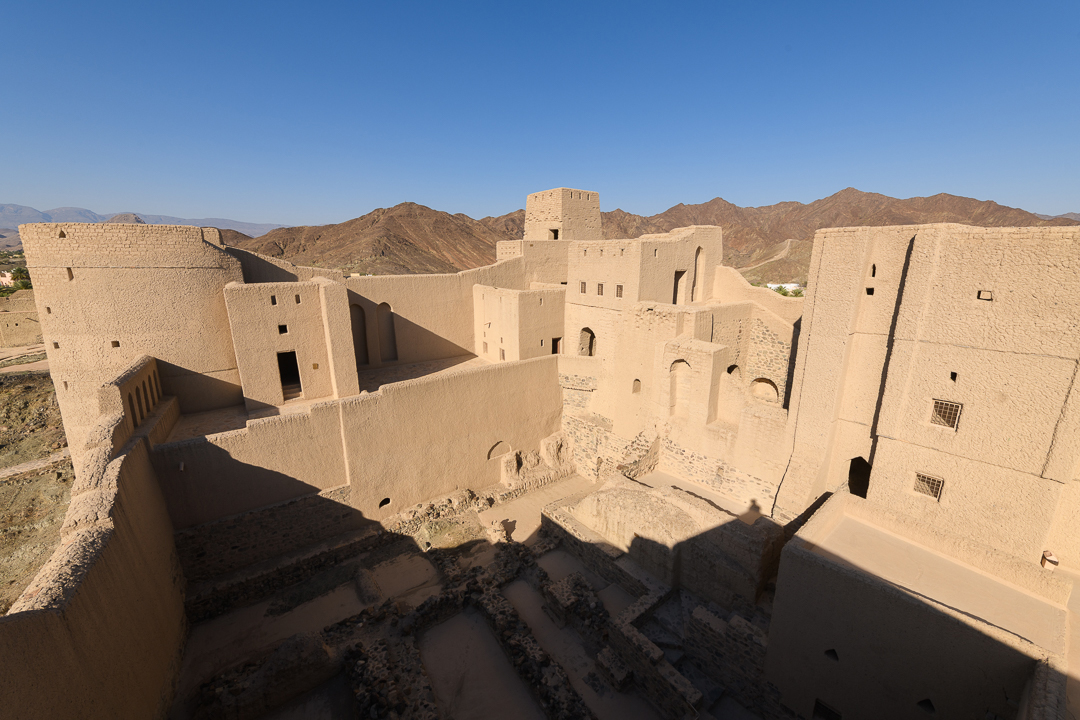
BAHLA FORT
Bahla Fort was inscribed as a UNESCO World Heritage Site in 1987 due to its historical importance and unique architectural features. Built before Islamic period, the fort was expanded during the period of Banu Nebhan tribe, who ruled the area in the 13th century. Bahla was an important center for trade and commerce, and the fort served as a defensive stronghold to protect the town and its inhabitants.
The fort is built of mud bricks and is surrounded by a wall with watchtowers and battlements. Numerous towers and bastions are strategically placed around the fort, offering panoramic views of the surrounding area and serving as lookout points. The Fort has several buildings inside, including a mosque, a well, and living quarters.
- Location : Wilayat Bahla
- Governorate: Al Dakhiliyah
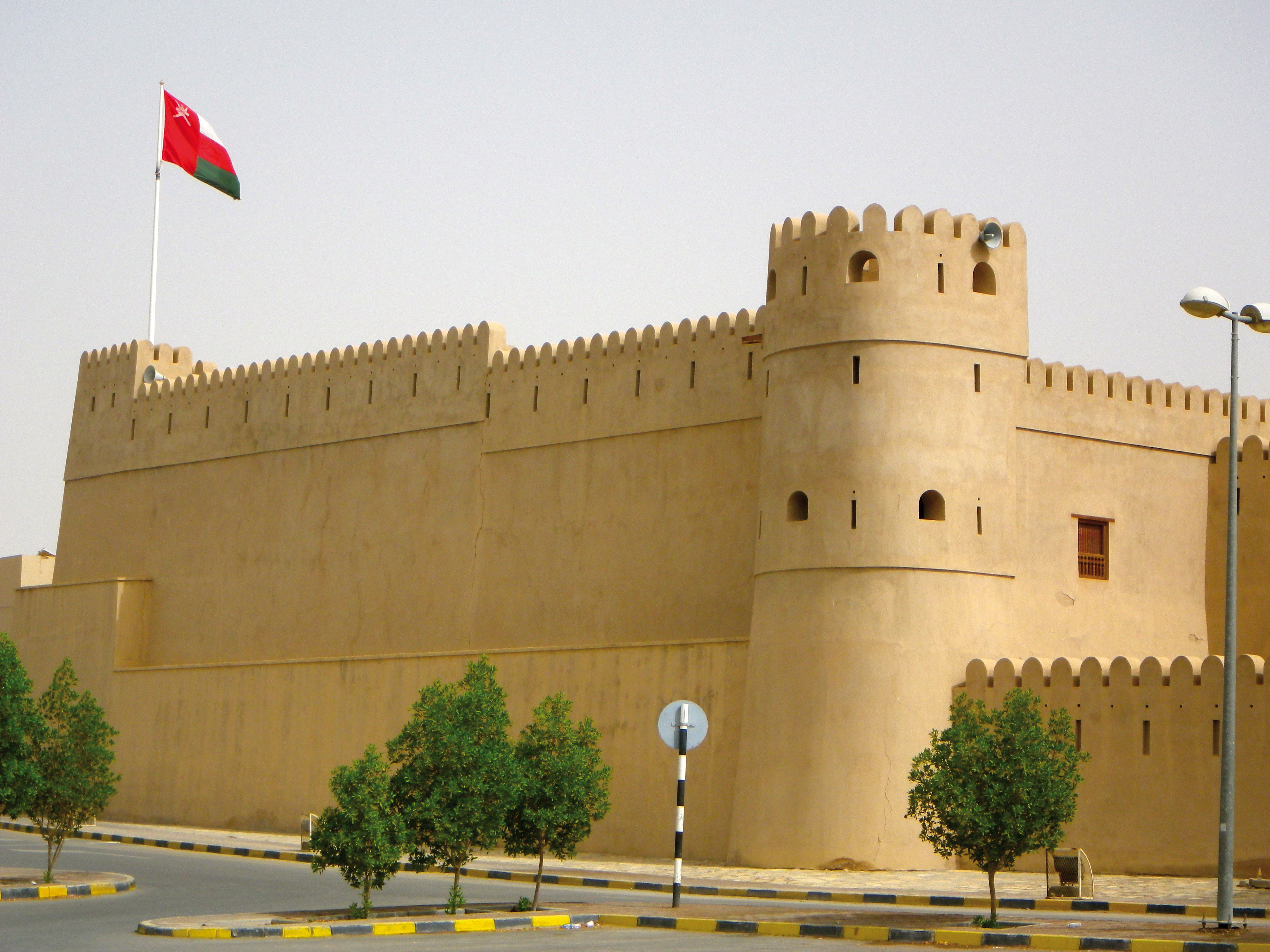
IBRI CASTLE
Built more than 400 years ago, the Ibri Castle stands at the site of utmost prominence in the city of Ibri, where merchants travelling between different regions of the Arabian Peninsula stopped to trade their goods. The area today has become home to the bustling Ibri Souq, which is full of traditional handicrafts and silverware. The Castle contains an old mosque, characterized by its roof made of compressed gravel.
- Location : Ibri
- Governorate: Al Dhahirah
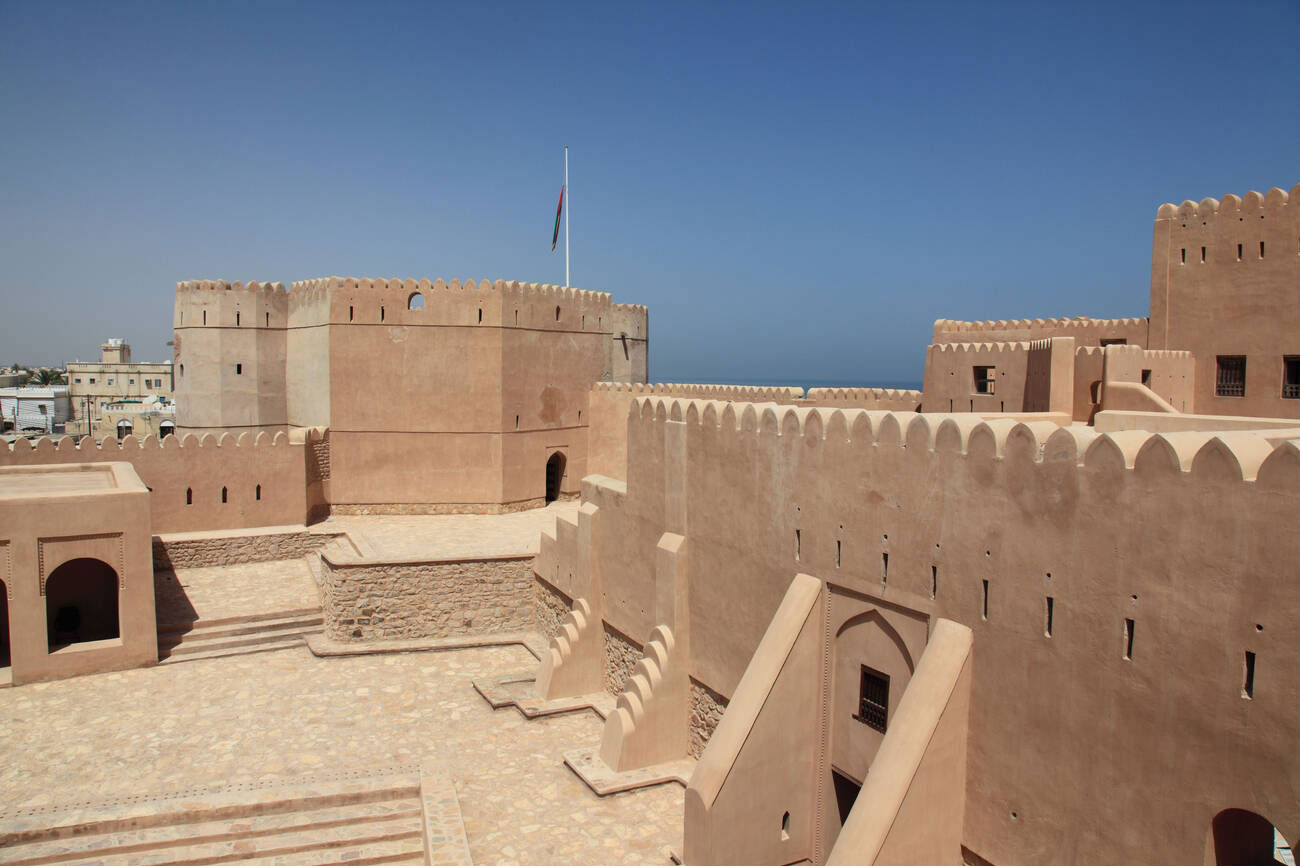
BARKA CASTLE
Barka is famed in Omani history for being the site of the ousting of the Persians by Ahmed Bin Said in 1747. Having been renovated in the 1980s, the Castle has four towers, one of which has an unusual octagonal structure. The Castle renders an excellent view of the sea and its surrounding areas.
- Location : Barka
- Governorate: South Al Batinah
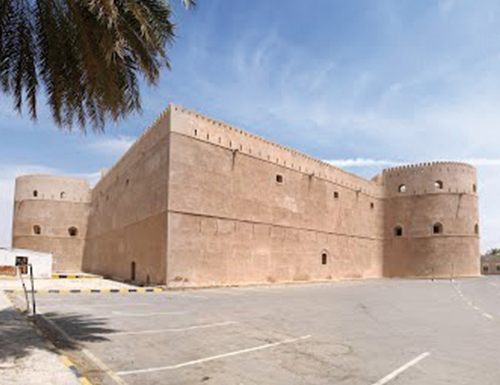
AL HAZM CASTLE
The Hazm Castle is a marvel of the architectural prowess of its builders, and is a vivid example of Islamic constructional masterpieces. Built in 1711 by Imam Sultan Bin Saif the 2nd, the Hazm Castle has an extensive network of tunnels and dungeons. The colossal wooden doors are intricately carved, and have receptacles for pouring boiling oil or date honey on intruders. Set on the banks of a wadi, this building is a great place to explore.
- Location : Enroute to Rustaq from Muscat / 20km from Rustaq
- Governorate: South Al Batinah
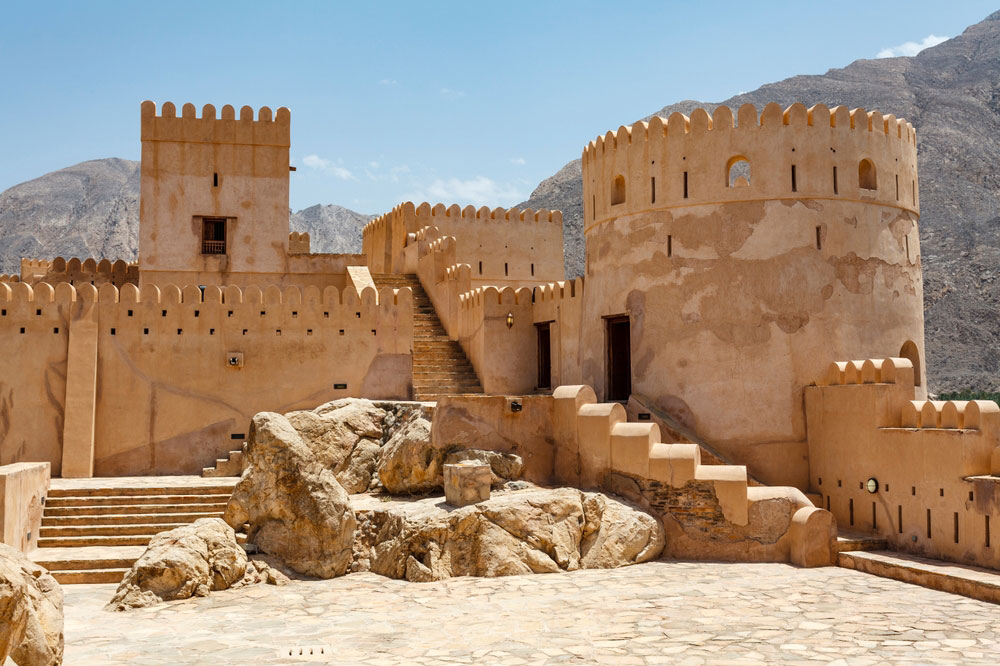
NAKHAL FORT
Nestled amongst the lush palm orchards of Wilayat Nakhal in the governorate of South Al Batinah, Nakhal Fort is one of the most prominent of historical monuments in Oman. This immense fortification holds a commanding position in the town with stunning views of the wadi and green plantations. The most interesting aspect of Nakhal Fort is that it seems to have been constructed with no particular architectural plan; built around an irregularly shaped rock, the rock has become a part of the building itself.
Phone : 98888990
- Location : Wilayat Nakhal /120km from Muscat
- Governorate: South Al Batinah
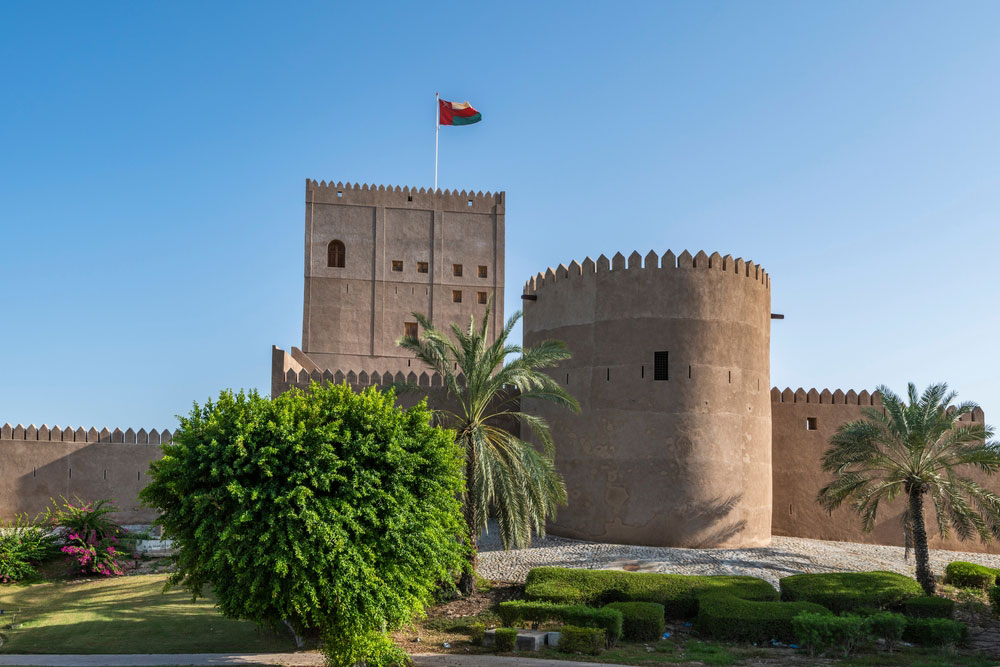
SOHAR FORT
Sohar Fort, overlooking the Sea of Oman, was built in the 7th century AH/13 AD or 8 AH/14 AD. It is a rectangular building in white color with four bastions, one of which does not have openings for cannons, while the other three bastions are semi-circular with a number of cannons. The Fort also has a high tower consisting of three floors and a number of water wells.
Sohar Fort in terms of architectural composition is considered a fortress, and the Fort has been used throughout different times as a center of political and administrative authority and military leaders. The Fort was renovated at different times, the last of which was during the prosperous era (1983-1985 AD), and turned into a museum for the history of Sohar.
- Location : Sohar
- Governorate: North Al Batina
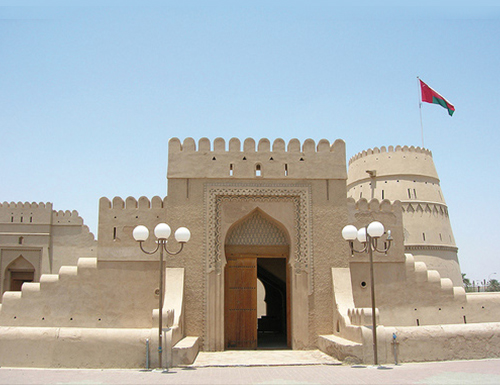
AL KHANDAQ CASTLE
Constructed in the 19th century, during the reign of Sultan Said Bin Sultan, Al Khandaq Castle has a rich history tied to the defense and governance of the Al Buraimi region. Its name, “Khandaq,” meaning “moat,” reflects its defensive purpose. The castle was a critical military stronghold, safeguarding the area against invasions and serving as a center for local administration and authority.
The architecture of Al Khandaq Castle exemplifies traditional Omani fortification design, characterized by its robust and functional structure. The castle features thick defensive walls, watchtowers, and a moat that enhances its defensive capabilities. The layout includes various rooms, halls, and courtyards, designed to accommodate both residential and military functions.
- Location : Al Buraimi, from the Market Square
- Governorate: Al Buraimi
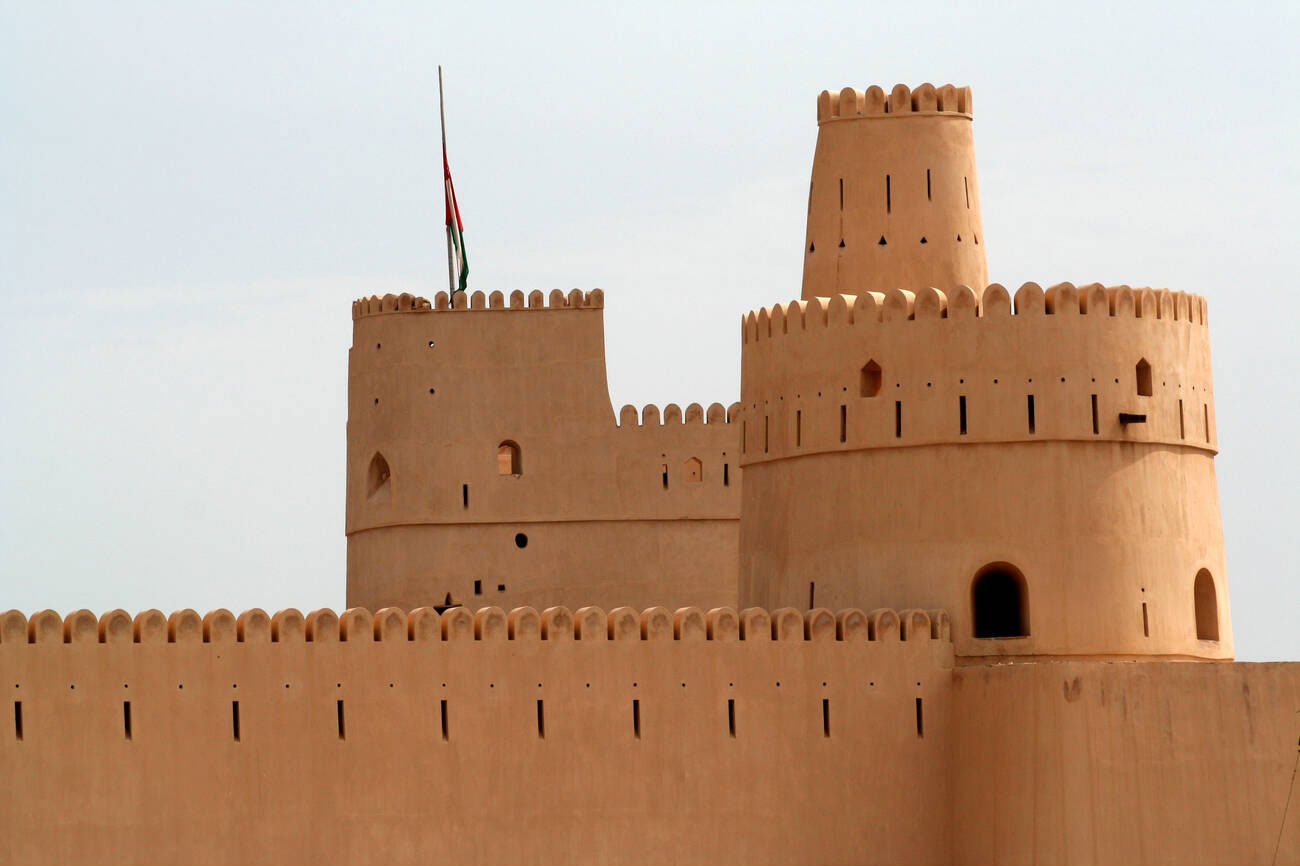
BILAD SUR CASTLE
Believed to have been constructed in 1800 with an objective of warding off enemy tribes, the Bilad Sur Castle is a majestic fortress that stands proudly on the Bilad Sur Plain. The castle consists of different towers known as A’Souq, Jalan, Al Khandaq, and an extraordinarily shaped fourth one that has two stories.
- Location : Sur, left off the Main Street
- Governorate: South Al Sharqiyah
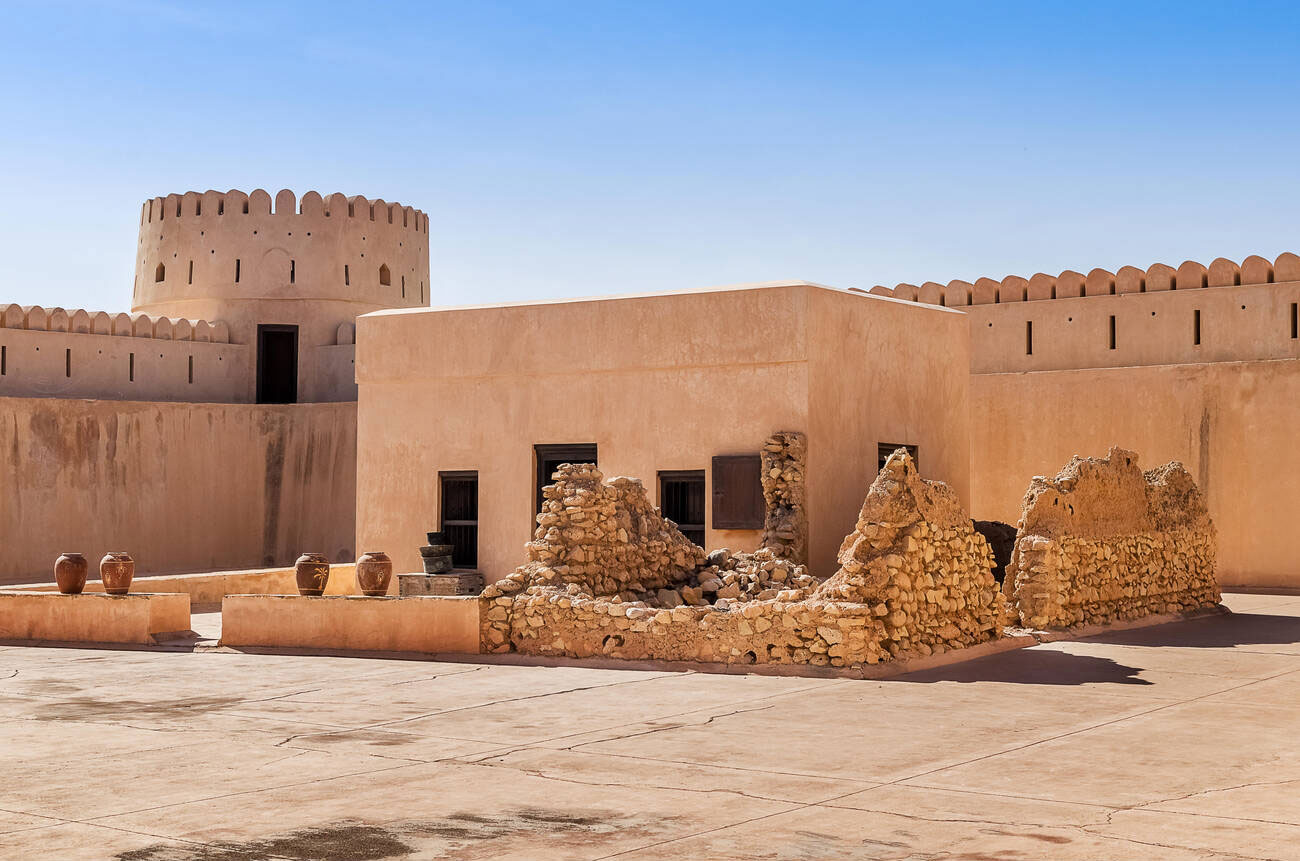
SUNAYSILAH CASTLE
This Castle was built on a hill located in the middle of Snaisla Arae, about 450 years ago, in the sixteenth century AD.
The castle is built on a classic square plan with four round watchtowers. It was one of the important defensive system in Sur. The rooms inside the castle have various traditional artefacts like poetry, Quran stands, carpets etc. Visitors can’t miss this castle, as its presence looms over the town center. The Castle offers a magnificent view of the Sur City
- Location : Wilayat Sur
- Governorate: South Al Sharqiyah
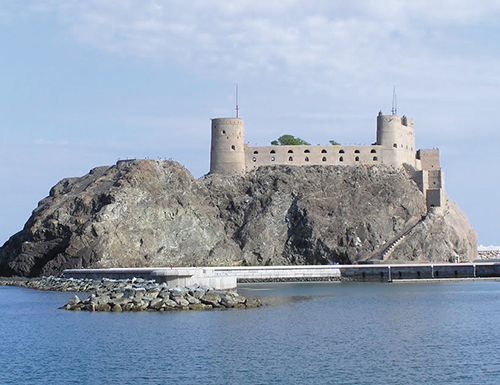
AL JALALI FORT
Built in the 1580s by the Portuguese and was re-built by Al Ya’arubah who were the rulers of Oman between 1624-1742, Al Jalali Fort (also known as Al Sharqiyah Fort) is situated in old Muscat and overlooks the stunning Sea of Oman. The fort consists of two imposing towers connected by a wall punctuated by holes for cannons. The building is completely isolated and cannot be accessed from its rocky façade; instead, there is a small bridge and stairway ending at one of the holdouts for a safe exit.
Visitors can view the castle only from outside.
Temporarily closed for visitors.
- Location : Old Muscat, Muscat
- Governorate: Muscat
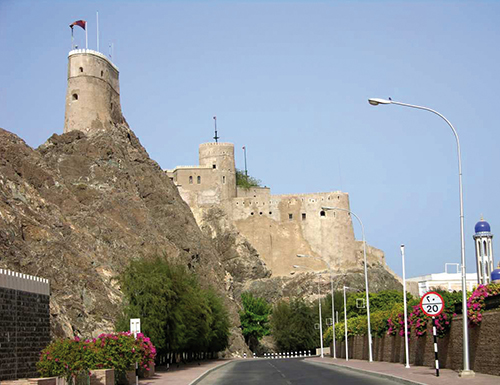
AL MIRANI FORT
Also known as Al Gharbiya Fort, Al Mirani Fort is the neighboring bastion of Al Jalali Fort that renders a marvelous spectacle of the Omani-Portuguese architecture of the early times. Originally built by the Portuguese and was re-built by Al Ya’arubah, who were the rulers of Oman between 1624 and 1742.
The fort commands a sight of high rocky hills at the end of the west wall, it can be reached by climbing a flight of stairs carved into the rock. A large dock is built at the base of the mountain.
Timings: Sun - Thu: 08:00 am - 12:00 am
@almiranifort
www.experienceoman.om
- Location : Old Muscat, Muscat
- Governorate: Muscat
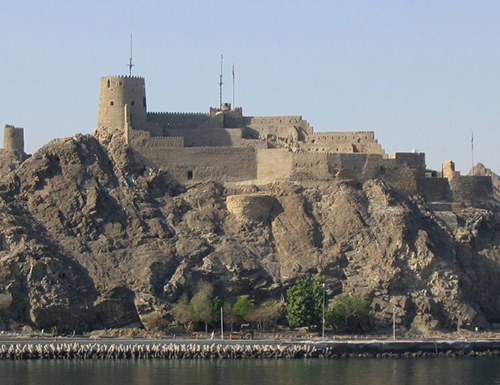
MUTTRAH FORT
Located on top of rocky hills, Muttrah Fort stands tall against the sea and strong winds that waft the fragrant memory of ships gone by, ships that once sailed these azure waters. Built by the Portuguese in the 1580s and was re-built by Al Ya’arubah who were the rulers of Oman between 1624-1742, this fort dominates the eastern end of the Muttrah Harbor, and consists of three circular towers: a huge one sitting on the summit and the other two are located to the west and the north.
Tel: 97031433, 91130765, 77000909, Instagram: muttrahfort
Location: Muttrah Corniche | Governorate: Muscat
Timings: Sun - Sat: 08:00 am - 12:00 a
#experienceoman
- Location : Muttrah Corniche
- Governorate: Muscat
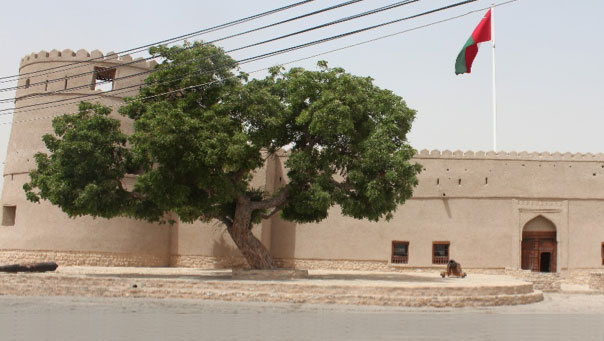
QURIYAT CASTLE
Quriyat castle is one of the most important historical landmarks of Muscat Governorate. Quriyat castle was built in the 13th century AH (19th century AD) during Al sayyid Said Bin Sultan reign. The castle features traditional Omani architectural elements, including thick walls, round watchtowers, and wooden doors. Quriyat Castle served as a defensive stronghold to protect the town and the surrounding region from maritime attacks and local uprisings. It also functioned as the administrative center for the region. Inside the castle, visitors can find a mosque, living quarters, a prison, and various rooms that were used for administrative purposes. The castle also has a well and storage facilities for food and water. The castle has undergone restoration to preserve its historical and cultural significance.
Tel: 71185740
- Location : located in Al-Souq neighborhood of Wilayat Quriyat
- Governorate: Muscat
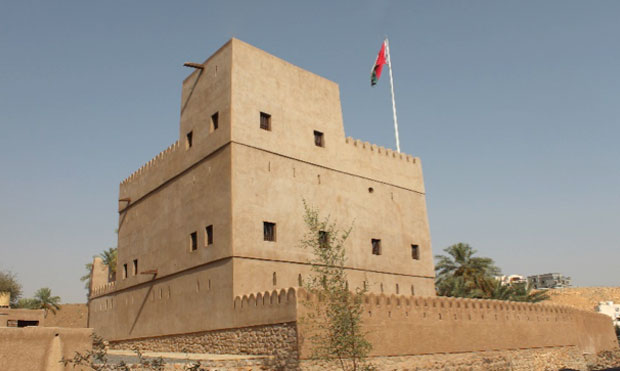
BAIT ALMAQHAM
Bait AlMaqham is located in Wilayat Bawshar in Muscat Governorate. This fortified house was known as the Bait AlMaqham due to its location in Hillat Al-Maqham in the Bawshar suburb. It was also known as the “Grand House” because it was the largest historical house in the neighborhood. Built in the 18th century for Sayyida Thuraya bint Muhammad bin Azzan Al Busaidi, this historical house showcases traditional Omani architecture blended with military elements, highlighting its defensive capabilities. The house consists of three floors with a mix of irregular and spacious rooms, some with pointed arches and wooden ceilings. The structure has undergone several restorations, the most recent in 2010, to maintain its historical and architectural integrity.
#experienceoman
- Location : Bawshar
- Governorate: Muscat
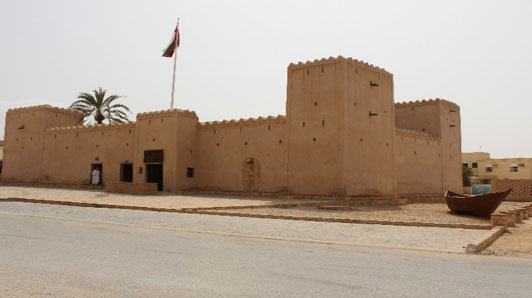
TAQAH CASTLE
The construction of this castle dates back to the 19th century AD. It is a rectangular building with a length of (33.8m) and a width of (15.5m). It consists of two floors and has two towers on the western side.
It is considered one of the most prominent historical monuments in the Wilayat Taqah because of its vital role as an administrative center for the affairs of the state in the past. The Castle was used as an important center for Government functions, in addition to being the residence of successive governors. Taqah Castle is characterized by its beautiful, high-level artistic colors and its multiple windows, which are equipped with interlocking wooden curtains and arches that look like keyholes in their shape. It is characterized by the collections and exhibits of crafts from various marine, rural and desert environments.
- Location : Wilayat Taqah, Salalah
- Governorate: Dhofar
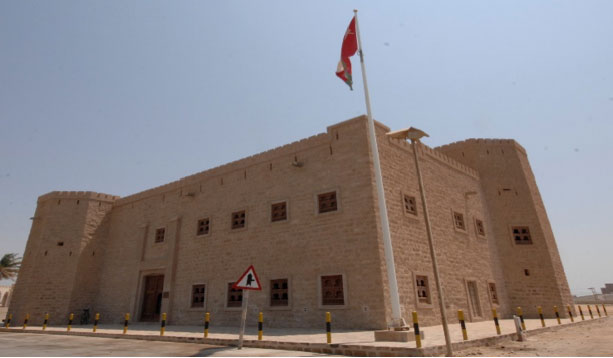
MIRBAT CASTLE
Mirbat Castle is one of the prominent historical landmarks in the Wilayat Mirbat. The total area of the Fort is 467 square meters and its height is 12 meters. The building consists of two floors and contains two towers, one in the southwest corner and the other in the southeast corner.
Mirbat Castle is one of the prominent historical landmarks in the Wilayat Mirbat. The total area of the Fort is 467 square meters and its height is 12 meters. The building consists of two floors and contains two towers, one in the southwest corner and the other in the southeast corner.
This Castle has played active defensive and administrative roles throughout history, and this fort was used as a state administration center. It was also the residence of many governors and officials.
The Castle was renovated last in 1992-1993 AD
#experienceoman
- Location : Wilayat Mirbat
- Governorate: Dhofar
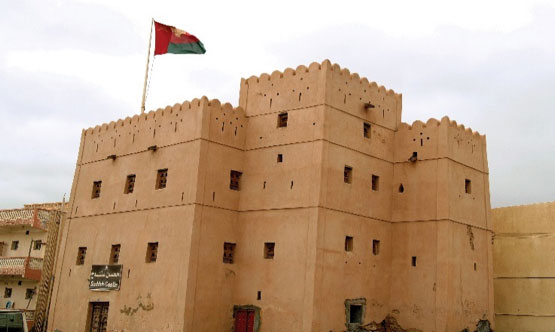
SADAH CASTLE
Sadah Castle is located in the Wilayat Sadah, and it is considered the last eastern fortification of the Dhofar coast. It was used to protect the region during wars. It is mentioned that it was built during the reign of Sayyid Tayimur bin Fasial (1332-1351 AH / 1913-1932 AD), and its importance increased during the reign of Sultan Said bin Taimur (1351). -1390 AH / 1932-1970 AD).
The Castle consists of three floors: The first floor includes Al-Barza (it is a reception council in which people’s cases are decided by the governor, the judge, and the notables of the region). The second floor was used as a residence for the governor, while the third floor includes wings and a tower used by the soldiers.
The Castle was restored in 1991 AD
- Location : Wilayat Sadah
- Governorate: Dhofar
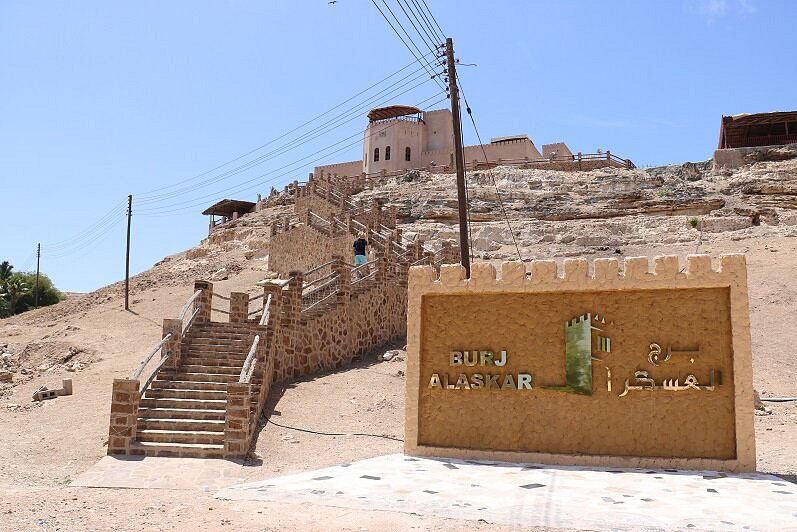
BURJ AL-ASKAR
Burj Al-Askar, also known as Al-Askar Fort, is a historic fort located in the Dhofar region of Oman. This fort is an integral part of Oman’s rich architectural heritage, which showcases a blend of traditional techniques, locally sourced materials, and intricate designs. The fort dates back to the 19th century, a period marked by significant fort construction in Oman for defensive purposes. Traditional Omani forts, including Burj Al-Askar, often have hidden passages, towers, and intricate carvings on doors and windows. These features not only served functional purposes but also showcased the craftsmanship and aesthetic sensibilities of the time.
Tel: 91121999
- Location : Salalah
- Governorate: Dhofar
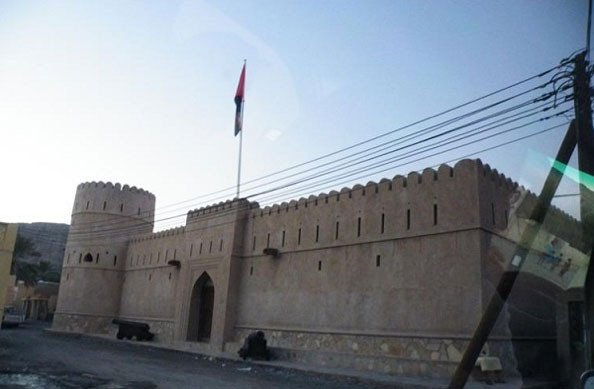
AL KAMAZRAH CASTLE
The Castle is located on flat land in Haret Al Kamazra in the Wilayat Khasab. Its construction dates back to the era of Faisal bin Turki in 1898 AD. Local materials like sarooj (water-resistant mortar), stones, and clay were used in its construction. The Castle is a square-shaped building with two circular towers located on opposite corners, connected by a wall that reaches a height of three and a half meters. Inside the Castle, there are some residential rooms, in addition to the presence of special rooms for ammunition and weapons. There is a well in the middle of the courtyard of the Castle.
The Castle was restored in the years 2005-2006 AD.
- Location : Al-Kamazara
- Governorate: Musandam
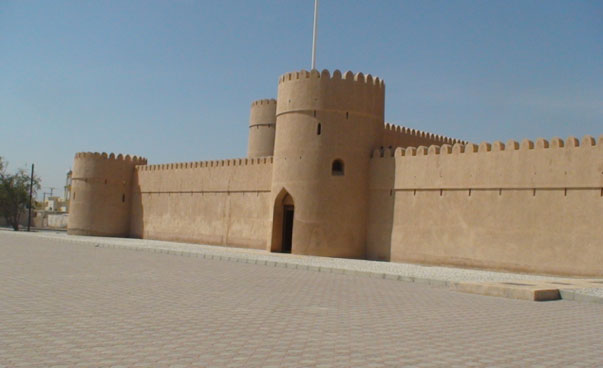
DIBBA CASTLE
The castle dates back to the pre-Islamic era, with subsequent renovations and enhancements during the Islamic period, particularly under the rule of the Portuguese in the 16th century. Dibba Castle served as a military stronghold, guarding the coastline against invasions and controlling trade routes in the Gulf of Oman. Dibba Castle features traditional Omani architectural elements, including thick stone walls, round towers, and battlements designed for defense. Its strategic location offers panoramic views of the surrounding area, which was crucial for monitoring and controlling naval movements. Visitors to Dibba Castle can explore its well-preserved structure, including its towers and walls, while enjoying the stunning views of the surrounding landscape
- Location : Al-Bayaa area in Wilayat Dibba
- Governorate: Musandam
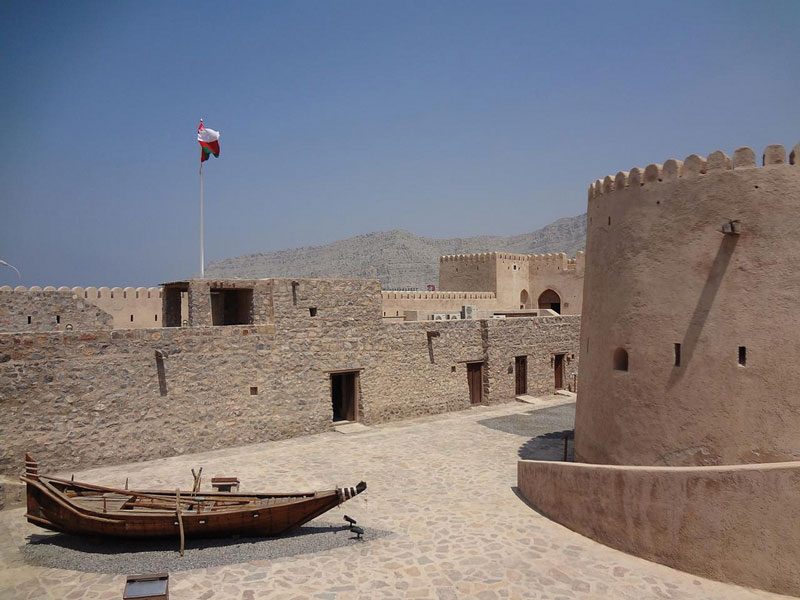
KHASAB CASTLE
Khasab Castle was constructed over the ruins of the old Portuguese Castle that was erected in the 17th century to keep a watchful eye on the Strait of Hormuz. A short walk away is the smaller Kamazrah Castle, which has spectacular mountain views from its battlements.
- Location : Khasab
- Governorate: Musandam
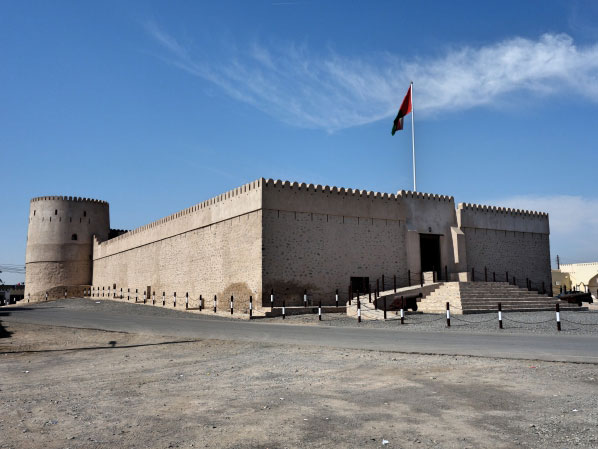
AL KHABOURAH CASTLE
Al-Khaboura Castle is 53 meters long and 24 meters wide and is surrounded by high walls built of mud bricks. The Castle was used as the seat of government and management of state affairs due to its strategic location. Al-Khaboura Castle consists of several rooms, including rooms for guards, rooms for visitors, a room for storing foodstuffs and weapons, and two rooms for the governor’s residence.
The Castle has two towers, one of them is circular in shape with a diameter of 7.5 meters, in the southeastern corner, and there is a rectangular tower or bastion with a width of 7.5 meters located in the circular corner.
The main entrance of the Castle is located on the northern side, with two cannons at the entrance, the Castle was last renovated in 1994 AD.
Phone: 90611051
@Alhuoson_altorathi_cafe
- Location : Al Khaboura
- Governorate: North Al Batinah
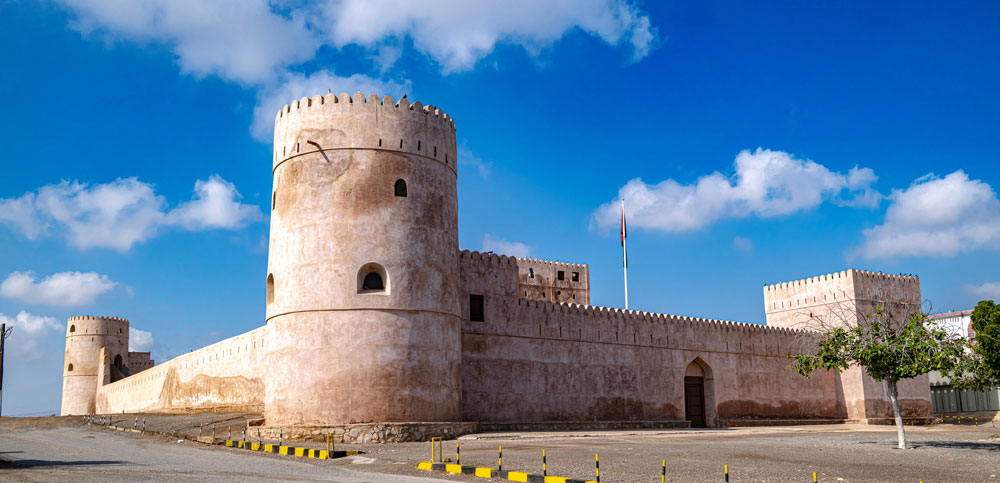
AL SUWAIQ CASTLE
Al Suwaiq Castle, located in the coastal town of Suwaiq in the Al Batinah Region of Oman, is a prominent historical fortress with deep roots in the country’s rich heritage.
Constructed in the 18th century, it played a crucial role during the Al Busaid dynasty. It served as both a defensive stronghold and an administrative center, reflecting its dual importance in military and governance affairs. The castle’s location along the coast made it a vital point for protecting the region from potential sea invasions and controlling maritime activities.
Al Suwaiq Castle exhibits typical Omani fortification architecture, characterized by its robust structure, tall watchtowers, and fortified walls. The castle includes several distinctive features such as large wooden doors, intricate carvings, and strategically placed openings for archers.
- Location : Al Suwaiq
- Governorate: North Al Batinah
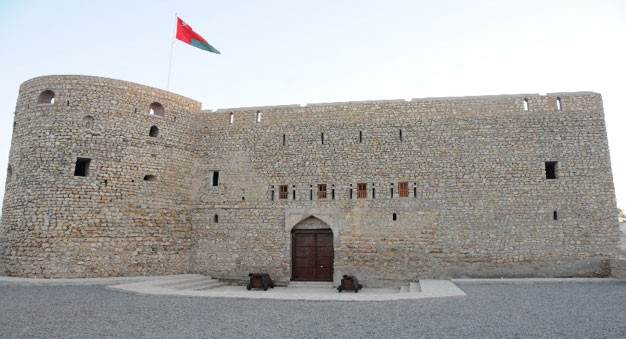
AL MUSANAAH CASTLE
Built in the 17th century during the end period of Al Yaruba dynasty and beginning of Al Busaidi period 1033-1153 AH (1624-1741 AD), marked by significant fortification efforts across Oman. The castle served as a defensive bastion against invasions and internal conflicts, illustrating its importance in the military history of the region. It also functioned asan administrative center, overseeing the surrounding area’s governance and trade.
Al Musanaah Castle showcases traditional Omani fort architecture, characterized by its robust and imposing structure. The castle features thick defensive walls, circular watchtowers, and strategically placed battlements. Inside, the castle comprises numerous rooms, halls, and courtyards designed for both residential and military purposes. Its architecture reflects the blend of functionality and aesthetic considerations typical of Omani Castles.
Location: Al Musana’a | Governorate: South Al Batinah
- Location : Al Musana’a
- Governorate: South Al Batinah
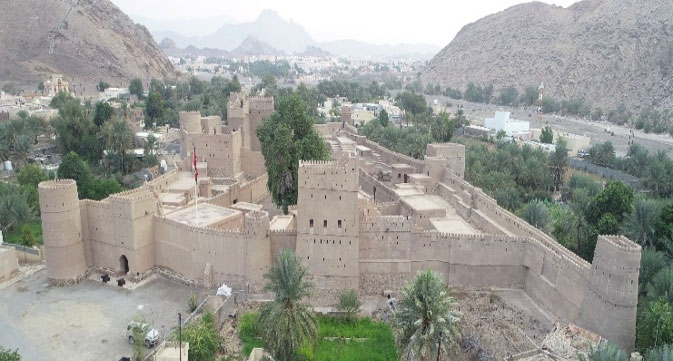
BAIT ALMARAH CASTLE
One of the important historical buildings in Oman, Bait Al-Marah Castle is also known as Yanqul Castle and located in Wilayat Yanqul in Al Dhahirah Governorate.
It is a large complex designed in a semi-rectangular shape, and contains a mosque and a group of houses within its wall. The Castle wall is supported by nine towers, and due to its strategic location and the durability of its architecture, the Castle has been inhabited until recently.
The Castle was built 400 years ago, when the Nabhani tribe reigned the area. The Castle was built by Makhzoum bin Falah, a member of the Nabhani family, at the beginning of the seventeenth century AD.
- Location : Wilayat Yanqul
- Governorate: Al Dhahirah
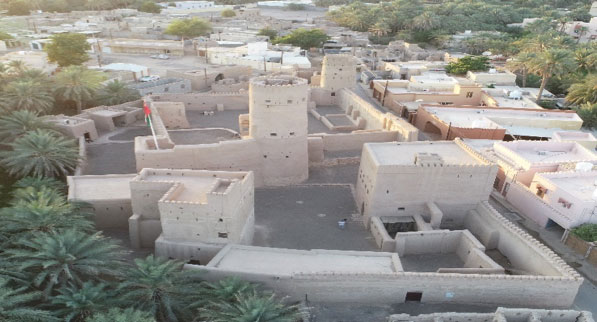
AL ARAQI CASTLE
Al Araqi Castle is located in Wilayat Ibri in the Al Dhahirah Governorate. It is a large rectangular Castle, divided into two parts, an eastern Castle, and a western Castle, with a spacious yard in the middle and containing two entrances and four towers.
The first floor includes ten rooms, two rooms in the two round towers, and the roof of the four towers has openings for cannons.
It is likely that the Castle was built in the early nineteenth century AD.
- Location : Wilayat Ibri
- Governorate: Al Dhahirah
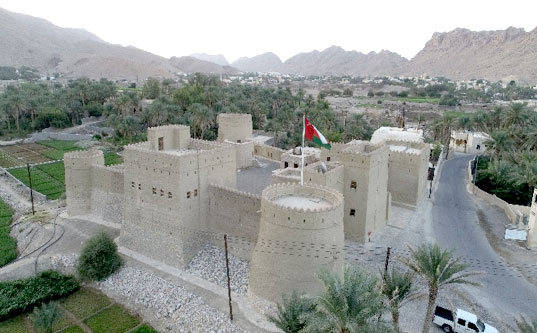
AL-MUNAIKH CASTLE
This Castle was built on a plateau, located in the middle of Alayai city of Dhank, in Al Dhahirah Governorate. This old Castle was constructed by the Faialin tribe, who settled in the state of Dhank.
The Castle consists of two floors, with four Towers, the most famous of which is the dome tower, which was equipped with a cannon. It has a main gate and a well for drinking water and storage places for weapons and another for supplies.
Many Sheikhs of the Al-Naim tribe successively used this Castle for residential purposes.
- Location : Wilayat Dhank
- Governorate: Al Dhahirah
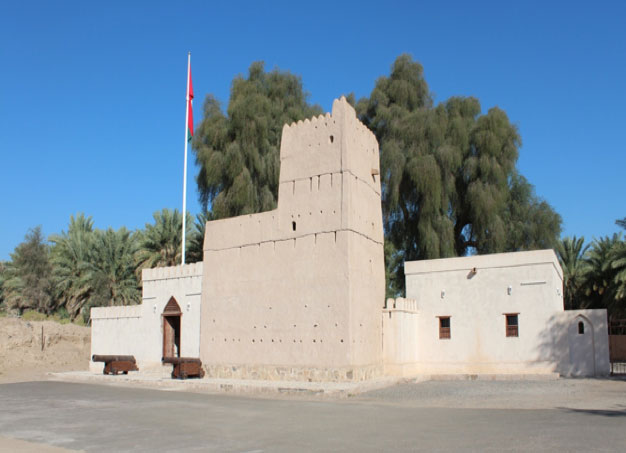
AL MAMOUR CASTLE
The Castle is located on a flat land in the midst of palm plantations in the village of Al Maamour, overlooking the palm plantations with large avenue in which events are held.
The structure consists of two floors, an entrance and a tower, and two cannons. The structure is rectangular in shape and has a water well within. It was previously used for defensive and residential purposes. The Castle is constructed with clay, gravel, plaster, sarooj, and wood.
The structure is well maintained over the years.
- Location : Wilayat Ibri
- Governorate: Al Dhahirah
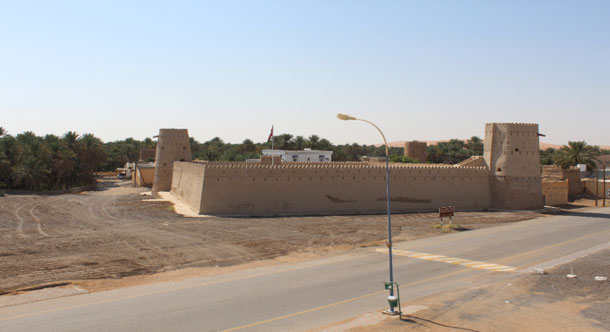
AL WASIL CASTLE
The Castle is located on plain land in the center of the village and overlooks a group of date palm plantations. The Castle was built by the Al-Hajarin tribe and was mainly used to repel surprise attacks by the mercenaries coming from outside Oman and defend the Village.
The Castle consists of only one floor with many rooms and has three entrances. The Castle has five restored towers and a wall connecting them. There is an antique market with a number of shops. Like other Castle of the region, it is constructed with Mud, gravel, plaster, sarooj and wood.
- Location : Al-Wasil, Wilayat Bidiyah
- Governorate: North Al Sharqiyah
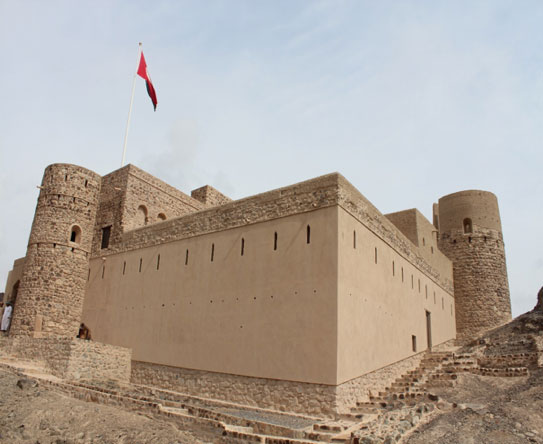
BAIT AL-KHABEEB CASTLE
Bait Al-Khabeeb Castle is located in Wilayat Al-Mudhaibi, it is an almost square-shaped building, which includes two circular corner towers. There are also a number of defensive fortifications, rooms, and stores.
The Castle was constructed during the thirteenth century AH (17th Century AD) The Castle was renovated during the time of Sultan Faisal bin Turki in the fourteenth century AH (18th Century AD).
- Location : Wilayat Al Mudhaibi
- Governorate: North Al Sharqiyah
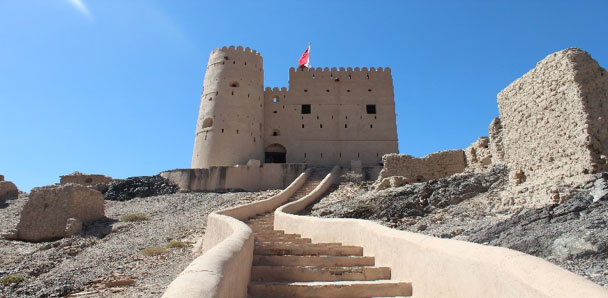
AL RAWDHA CASTLE
Al-Rawdah Castle is located on top of a mountain hill, was built with the aim of defending the town and providing protection through marine surveillance. The Castle with a total area of 326 meters, with a length of 24 meters and a width of 14 meters, consists of reception rooms for guests, a storeroom, a women’s room, a kitchen, and a main hall that is accessed through an arched entrance that leads directly to a rectangular hall, the walls of which are decorated with a number of traditional decorations.
The Castle was last restored in 1989.
- Location : Al-Rawdah in Samad Al-Shan, Wilayat Al-Mudhaibi
- Governorate: North Al Sharqiyah
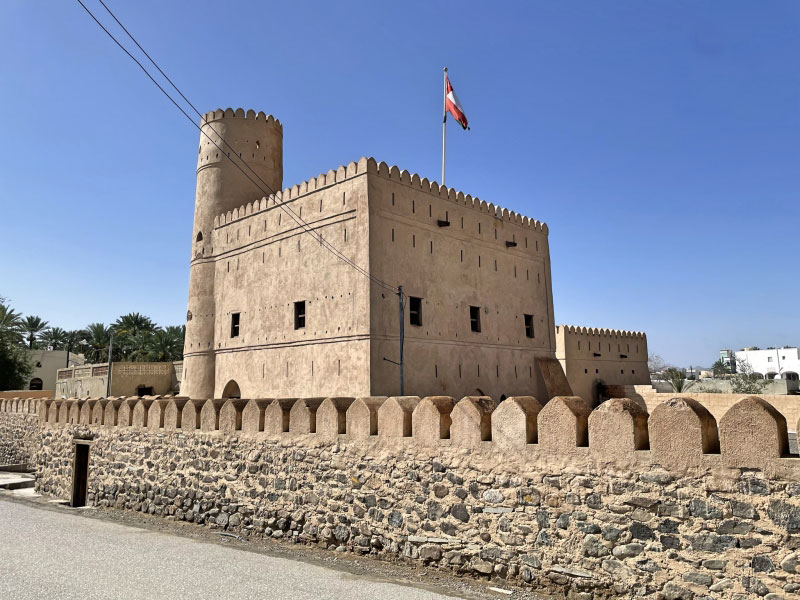
BAIT AL YAHMADI CASTLE
A fortified mud-brick mansion house. Built possibly around 300 years ago by Hafez bin Saeed Al-Maskari, located in the suburbs of Ibra on the edge of the town’s plantations, the structure is well maintained. The falaj (irrigation channel) that leads under the entrance way like a mini-moat is one of the attractive features of this location.
The house was restored in 1989 AD.
- Location : Wilayat Ibra
- Governorate: North Al Sharqiyah
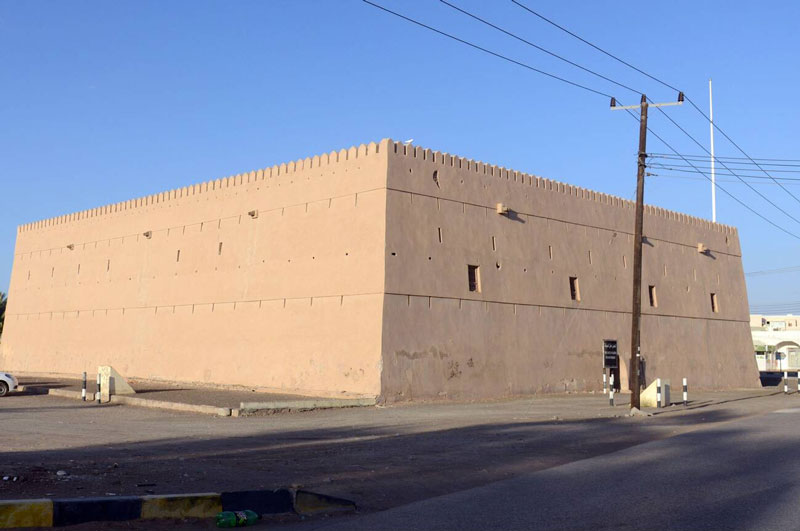
AL MINTARIB CASTLE
This Castle was built on a flat land in the middle of the village of al-Mintreb. The Castle was built in the 13th century AD during the reign of Bani Nabhan. It seems that the Castle was moved from its original location in the center of the country (Al-Nakhil) to its current location in 815 AH / 1412 AD, the restoration work was undertaken continuously over the years. With an area of 900 square meters, it has high fortified walls interspersed with small windows. In the past, this Castle was the center of religious power in the city.
The last restoration was in 1982 AD
- Location : Al-Mintreb, Wilayat of Bidiyah
- Governorate: North Al Sharqiyah
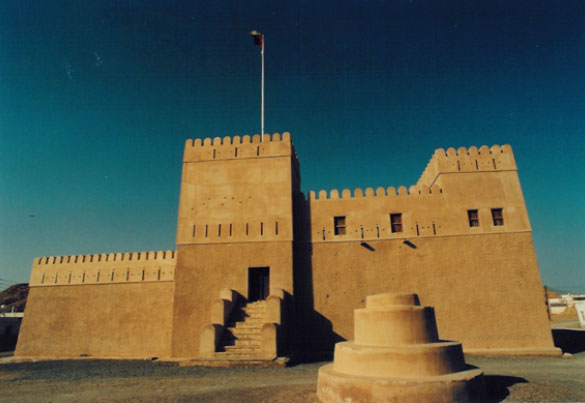
AL-AYJAH CASTLE
Al-Ayjah Castle is located in Al-Ayjah, in Wilayat Sur, South Sharqiyah Governorate. It has been restored and is situated on coastal land in the middle of the village. A unique feature of the fort is its location among residential houses. The Castle is square-shaped and was previously used for defending the village, but it is now used for tourism. The Castle consists of only two floors and has a single entrance and four towers. Inside the Castle, there are some artifacts, including swords, rifles, and cannons are displayed. The materials used in its construction include clay and gravel.
- Location : Al-Ayjah, Wilayat Sur
- Governorate: South Al Sharqiyah
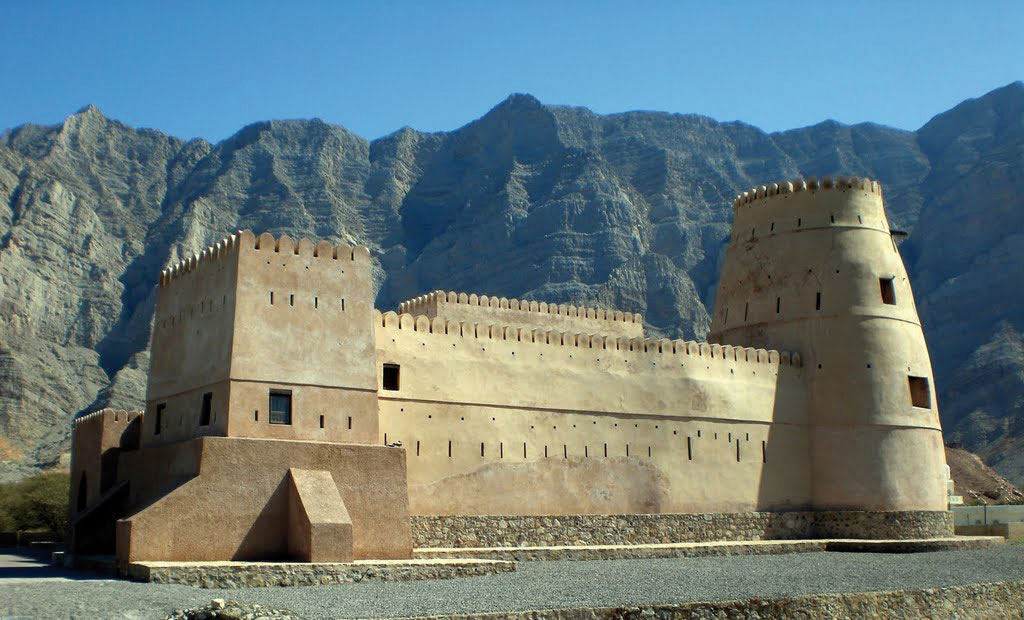
BUKHA CASTEL
Bukha Castle, located in the Musandam Peninsula of Oman, is a historical fortress that dates back to the 16th century. Situated strategically overlooking the Gulf of Oman, it served as a defensive structure against invading forces and pirates. The castle features traditional Omani architectural elements, including thick walls, watchtowers, and narrow windows designed for archers. Its elevated position offers panoramic views of the surrounding area, making it a significant historical and touristic site. Today, Bukha Castle stands as a testament to Oman’s rich heritage and its historical importance in maritime defense.
#experienceoman
- Location :
- Governorate: Musandam
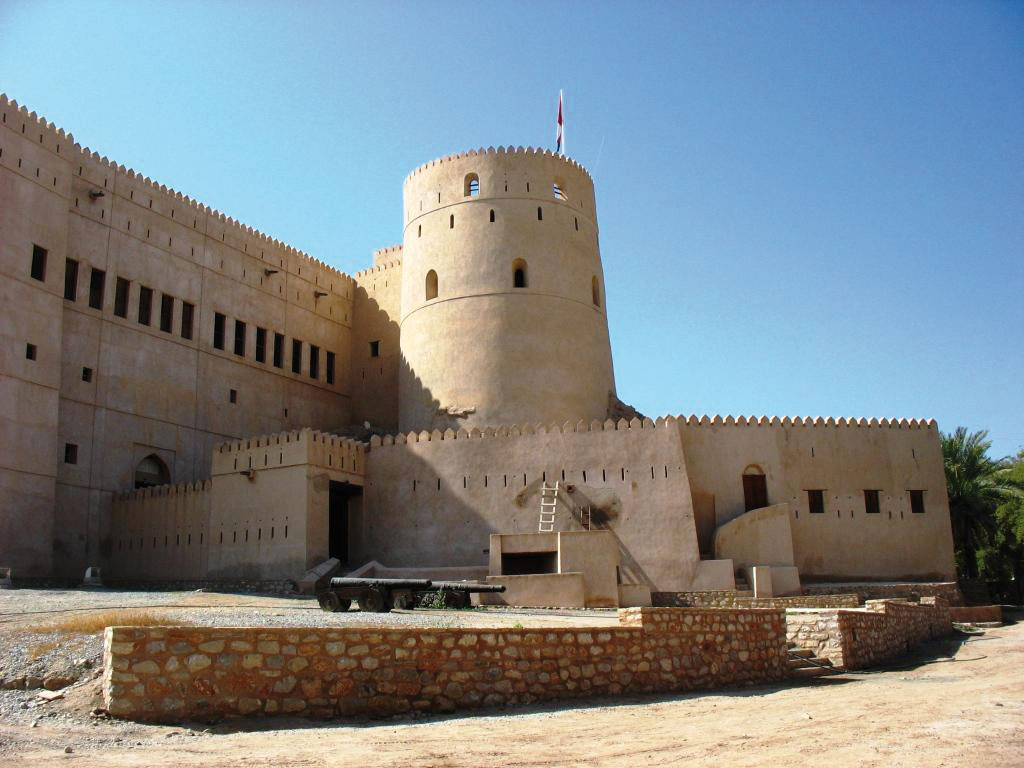
RUSTAQ FORT
Rustaq Fort has a rich history that dates back to pre-Islamic times, with significant renovations and expansions occurring in the 17th century under the Al Yaruba dynasty. The fort served as the capital of Oman during the reign of Imam Nasir bin Murshid Al Ya’arubi. It was a crucial defensive stronghold and played a pivotal role in protecting the region against invasions and maintaining internal stability.
Rustaq Fort is a magnificent example of traditional Omani military architecture. The fort features multiple layers of defensive walls, several towers, and battlements. Its massive structure includes a maze of rooms, halls, courtyards, and secret passages. Notable features include the Burj Al Riah (Wind Tower), which was used for surveillance and signaling, and the various wells and water systems that ensured the fort could withstand long sieges.
- Location : Rustaq
- Governorate: South Al Batinah
AL HILLAH CASTLE
Being the backdrop to Al Buraimi’s market square, Al Hillah castle was built in the 18th century during the reign of Saif Bin Sultan (the second).
The architecture of Al Hillah Castle is a fine example of traditional Omani fort construction. The castle features sturdy defensive walls, watchtowers, and intricately carved wooden doors. Inside, the castle includes various rooms, halls, and courtyards designed for residential, administrative, and defensive purposes. A staircase leading to the roof gives a panoramic view of the town, the market, and the neighbouring Al Khandaq Castle.
- Location : Al Buraimi, next to Al Buraimi Market
- Governorate: Al Buraimi
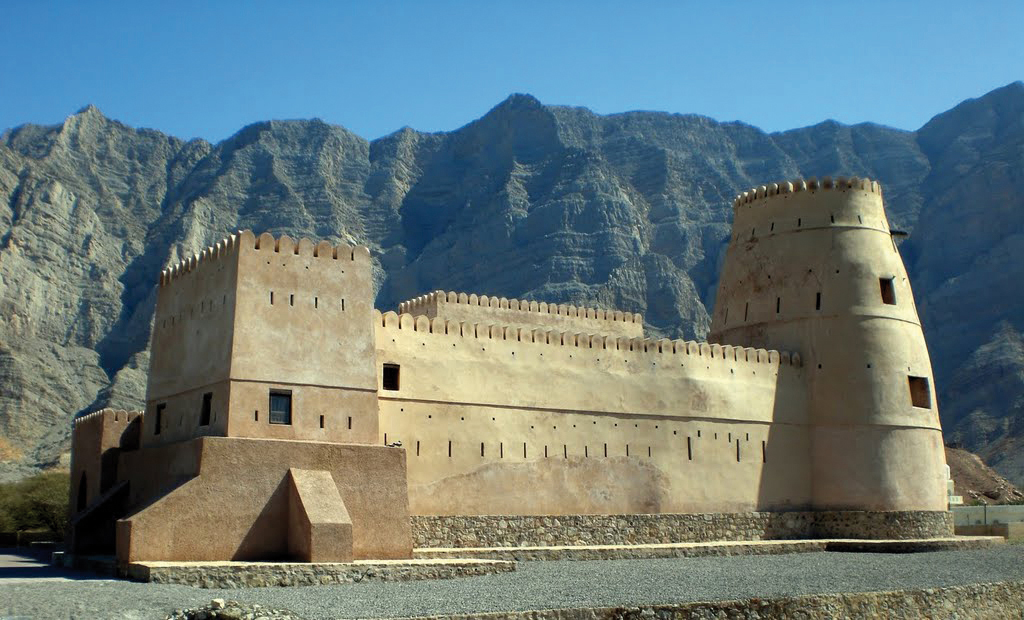
BUKHA CASTLE
Bukha Castle, located in the Musandam Peninsula of Oman, is a historical fortress that dates back to the 16th century. Situated strategically overlooking the Gulf of Oman, it served as a defensive structure against invading forces and pirates. The castle features traditional Omani architectural elements, including thick walls, watchtowers, and narrow windows designed for archers. Its elevated position offers panoramic views of the surrounding area, making it a significant historical and touristic site. Today, Bukha Castle stands as a testament to Oman’s rich heritage and its historical importance in maritime defense.
- Location :
- Governorate: Musandam
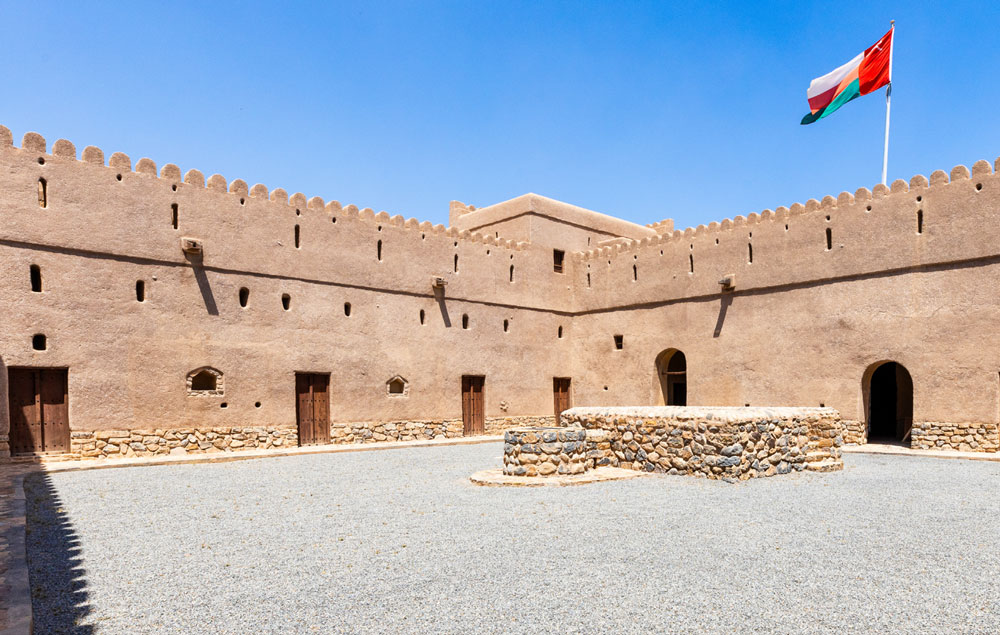
Bait Al Numan Castle
A fortified stronghold in the Wilayat of Barka, constructed by Imam Saif bin Sultan Al Ya’rubi between 1692 and 1711 AD, It is a square-shaped building with two floors and circular towers at each corner, each of which consists of three floors. This stronghold continued to be used as a rest house for prominent figures and dignitaries traveling from Muscat to Rustaq until a few decades ago. Bait al-Nu’man Fort was renovated several times. Imam Ahmed bin Said al-Busaidi fortified it between 1749 and 1783, a century after its construction. He reinforced its walls and added two defensive towers along a diagonal line, giving the guards the ability to fire in all directions. Thus, the building was transformed from a rural house into a fortified castle. From this height, visitors can enjoy views of the surrounding palm oasis, the Sawadi Islands in the sea, and the distant mountains.
- Location : Barka
- Governorate: South Al Batinah
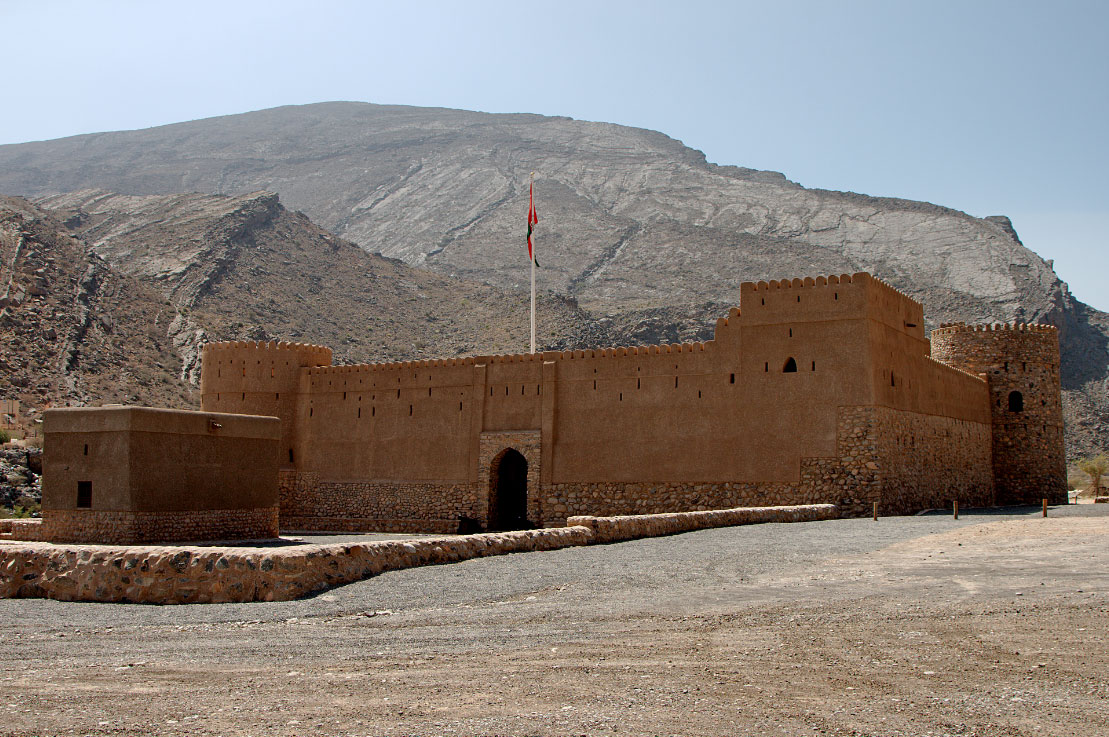
Al Awabi Castle
The Wilayat of Al Awabi is located in Al hajar Al Gharbi near Nakhal, waadi al Maawil, Al Jabal Al Akhdhar and Wilayat of Rustaq. It is 150 km from the capital.
Dating back to the early 19th century, it was built to protect the road leading to Wadi Bani Kharous in Al Awabi State and the old hiking trails leading to the Green Mountain. The castle is characterized by its impressive architecture and strategic positioning with beautiful view of the surroundings.
- Location : Al Awabi
- Governorate: South Al Batinah
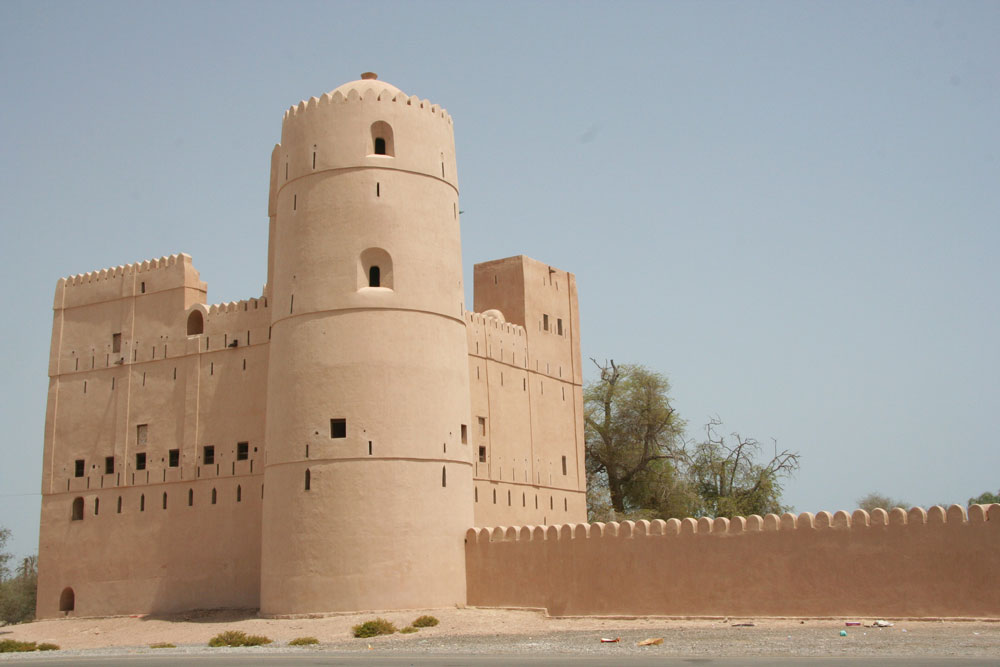
Al Mansour Castle
Located in the village of Al Mansour in the Wilayat of Rustaq, it was built by Imam Said, son of Imam Ahmed bin Said Al Busaidi. It is a cultural landmark and an architectural masterpiece. dates back to the early nineteenth century. Mansour Castle consists of three floors, the castle was built entirely from Omani mortar and mountain pebbles, with its ceilings made of kendal wood. All of the fort’s doors, windows, and walls are decorated with exquisite Islamic inscriptions.
Passing in front of the castle is a falaj called Falaj Al Mansour. It still flows, irrigating the palm groves surrounding the castle. It used to provide water for the castle residents. Also located on the western side of the fort is a “tarkaba,” a cooking area within the wall of the Mabsali palm grove
- Location : Rustaq
- Governorate: South Al Batinah



